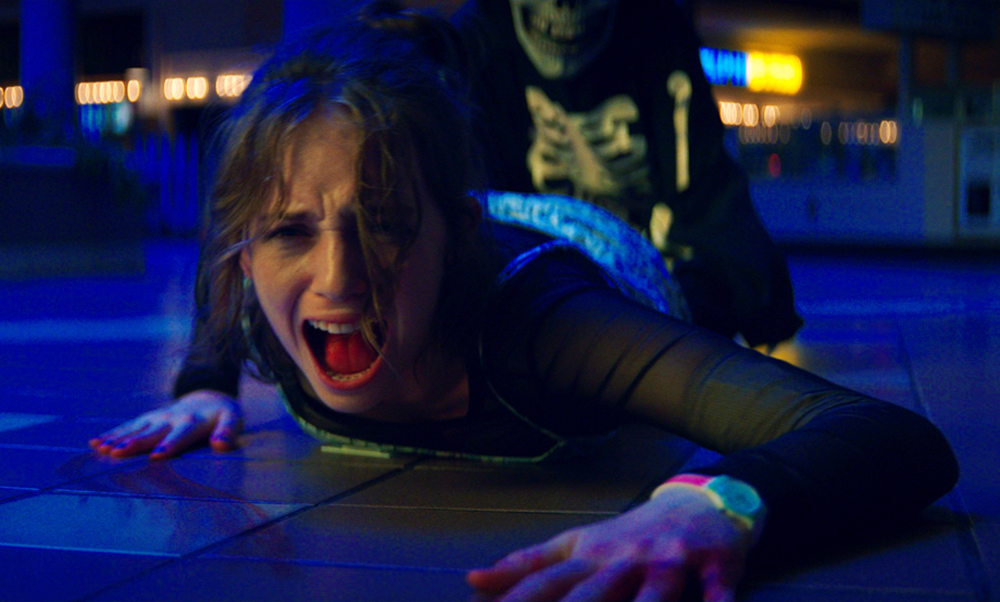It was, as you might imagine for any teen of the 1990s, quite a trip for Leigh Janiak as she walked onto set for the 1994 chapter of her “Fear Street” trilogy for the first time. Of course, she and her crew had spent months poring over every detail with a fine-toothed comb, from the posters of Temple of the Dog and PJ Harvey that hung on the walls in the home of her lead character Deena (Kiana Madeira) to the in-jokes that one might eventually find on the computer of her brother Josh (Benjamin Flores Jr.), yet there were still some elements that took her by surprise.
“I think that going into Deena’s bedroom, there were just these layers and layers of life that Jess Royal, my set decorator, laid in — stuff that you would never ever see and little ephemera taped to Deena’s boards that mention obscure bands,” recalls Janiak. “It was just amazing across the board.”
At one time, Janiak had read R.L. Stine’s “Fear Street” books in a bedroom like Deena’s, a fact that’s acknowledged by “Fear Street” being set in the writer/director’s home state of Ohio though Stine never made such a distinction for where the tortured community of Shadyside was actually located. Certainly Janiak had never imagined that one day she’s be adapting the series for the screen, though like most at that age, her mind reeled with the possibilities teed up by what could only be suggested in Stine’s young adult horror novels, and when the opportunity presented itself, it wasn’t an opportunity to go back to that warm nostalgic place in her own youth that was so appealing, but in fact having that ability to now see all the layers that could be built into it.
“Fear Street,” while hardly a direct adaptation of Stine’s books, has captured their spirit with a trio of films that are as compulsively watchable as the page-turners that inspired them and beyond making explicit the entertainingly garish murders that once had been left to the imagination (and the fiercely intelligent filmmaker has a far greater one than most), Janiak, more provocatively, seizes on an idea intended only by its original author as a bit of a canard where all bad things in Shadyside were thought to be the result of the innocent Fier family being burned at the stake for witchcraft. Having the unique opportunity to make three films at once with plans to release them within the same calendar year — a brainchild of former Fox CEO Peter Chernin who held onto the rights for some time before handing Janiak the keys — the director, with her longtime writing partner Phil Graziadei and an army of other writers required for the Herculean task of properly charting the curse that has bedeviled Shadyside for generations, digs deeper not only into the mythology Stine created, but an idea she explored before in her brilliant debut “Honeymoon,” about a couple who can’t recognize one another just after their wedding day when one becomes possessed by unknown forces.
When there is the belief in “Fear Street” that a rash of killings is connected to the spirit of the once-wronged pilgrim Sarah Fier, Janiak’s decision to hone in on the relationship between Deena and her girlfriend Sam (Olivia Scott Welch) from across the tracks in the tonier town of Sunnyside is the adaptation’s true stroke of genius. Touching on the veiled forms of segregation that have separated them when it’s clear that the violence in Shadyside that never seems to cross over into Sunnyside is less an act of crazed individuals than a shrewd city planning board, the focus on Deena and Sam — and those they find themselves running away from a masked killer with such as Kate (Julia Rehwald) and Simon (Fred Hechinger) in “1994″ — allows Janiak to observe how the personal whims of a selfish few can harden into systemic oppression over time, having influence over branding people a certain way before they are even being born and distorting the love that her central duo clearly have for one another as they are groomed to distrust their own instincts in favor of how they are seen more generally by the society around them.
As gleefully gruesome as some of the deaths are, the idea of an axe to the head is rightly envisioned as something one never sees coming and relatively painless in its quickness when compared with nasty prejudices that take far longer to die and while Janiak doesn’t skimp on visceral scares, the true horror in “Fear Street” lies in those moments when characters are asked to bare their souls to one another, not knowing how the other will respond, a literal necessity when anyone could be possessed by the spirit of Sarah Fier. The ambition of “Fear Street” may be reflected in its size as a series, but the true measure of it is in the thought Janiak and crew puts into both the craft and the story they tell and as the conclusion of “Fear Street” hits Netflix, the filmmaker graciously took the time to talk about what it was like to get her arms around such a massive undertaking, creating three separately satisfying stories that worked towards a larger narrative and the alternately delightful and horrifying experience of figuring out how to pull off so many murders.
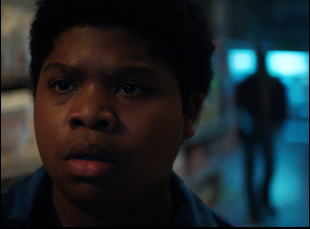
When I get approached about a project, it’s [about whether] can I find that thing that makes me excited, like “Oh, there’s a reason why this should exist out in the world” beyond me liking it, so it’s really been about finding the different things that I respond to. I’m a huge genre and horror fan, so often the things I tend to respond to are in those different subgenres and I’ve just been really lucky to be able to play around with a lot of different tones and worlds.
The question I asked myself when I came aboard [“Fear Street”], was I love these books and I love the slasher genre, but how do we justify telling these stories now and what do we do that makes them new? Because I wanted to indulge in that amazing nostalgia and [make] a love letter to these classic eras of film, but also I didn’t want to ever dip into parody or mimicry, so that was really relying on creating this narrative of characters that felt to me were new and weren’t represented in film and TV that was happening in the ‘70s and the ‘90s. Obviously, we could find new kills and things like that, but it was the characters and hopefully caring about their emotions that makes “Fear Street” feel new and not just, oh, we’re watching something we’ve seen a million times.
Not only do you do that, but until I saw it I didn’t realize how rare it is to see a female killer in a slasher film, which is strangely empowering and very exciting.
That was challenging because it’s weird and very traditionally gendered, so [it was a question of] how do you make a female slasher killer and how do you make her feel scary, so there was a lot of work that went into Ruby, thinking about how she would kill and how she would approach you, so I was also very excited when we landed on Ruby.
Having “Honeymoon” as a frame of reference, it was exciting to see you once again digging into the idea of not knowing the people you’re closest to when possession rears its ugly head. Was that actually your way into the story?
Yeah, clearly I have a thing that needs to be discussed with my therapist. [laughs] But [it was] one hundred percent this idea of identity and how well you know yourself and how well you know the people around you because there’s these moments throughout the three movies where you see characters that are in their last moments with the person that they love, trying to reach out to them and saying, “it’s me, please, it’s me” with varying degrees of success as far as how that works out and whether or not they can convince the person that’s attacking them to stop. And if you can peel that back, I’m interested in ideas of identity, but also love stories that are messed up and twisted.
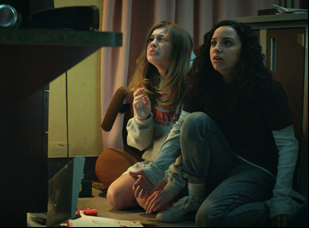
Yes, history repeating itself and cycles of time, things that happened in the past made right and the idea of fate and soulmates — these are all ideas I am obsessed with, so it felt like with these three movies, we had a chance to stay with the thing that’s been told throughout history [and show] how it needs to be changed because of X and X and X, so it was always a part of it. One of the earliest ideas was to use the cast from the ‘90s and the ‘70s in “1666” and I felt like that was really cool [because] beyond showing our characters representing versions of their characters [in different time periods], a lot of the characters that end up passing away and dying in the third movie are ones that live later on or vice versa, so it was always part of it and one of the things that I love personally.
These undoubtedly had to be planned down to the last detail before going into shooting, but was there any leeway once you got on set to rethink things about the next movie you were shooting after getting a sense of the tone or the feeling of the one you were in the middle of working on?
Yeah, we had a nice prep. I forget how many months it actually was and it was not enough. [laughs] I don’t know how long you would have to prep to properly plan for three movies. But we certainly still had a lot of loose ends once we started shooting and tonally, I knew where we were going to be for all three. My [director of photography] Caleb [Heymann] and I prepped a lot and it was the same with my art department, but one of the things that did happen organically on the camera side of things, we’d [recognize on set], “This frame here” or “this moment,” we can actually stage this moment similar to what we did in ’94, so there was a lot of finding those opportunities for framing and for blocking.
We called them “echoes” as we were shooting and the same thing happened with our locations and our space because [if] you’ve seen the movie, the geography is shared across the three movies. It’s like mall [in “1994”], camp [in “1978”], and village [in “1666” all are on the same land], so we would find ways to think about that, like what if we constructed this piece here so that under the mess hall is similar to being under the church and under the meeting house in 1666. Ultimately, that spewed over into editing too and when we got into post, Rachel [Goodlett Katz] and I would look and think, “We’ve got an opportunity here, let’s use a flashback or a flash here to really cement home things,” so it was an ongoing, really fun part of making the movies.
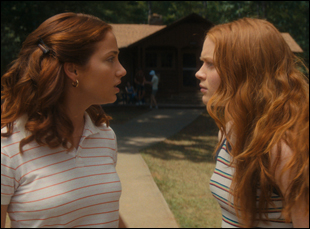
That might be something that’s in my subconscious. [laughs] For these movies, it was really about the color schemes for each movie being different. For the ‘90s, we wanted to live in this ‘90s world, which was a little more straightforward, but we wanted to lift it up and make it a little brighter and more colorful, so I worked with Skip [Kimball], my colorist who’s amazing, to get this really poppy, contrasty, saturated look that really leaned into the lighting and the things that Caleb had created on the production side of things. My production designer Scott [Kuzio] also knew what that palette was going to be, so then when we moved into the ‘70s, we knew we were going to be living in a more warmer universe — we also had daylight, which we didn’t have very much of in ’94. [laughs] We were looking back at classic ‘70s movies and we put a lot of grain on that movie to give it that gritty Super 16 feeling. And 1666 was actually very interesting color-wise because the early conversations I had with my costume designer Amanda [Ford], she was bringing me stuff that had lots more pops of color than ultimately made sense, but we were really living in a very neutral palette across the board, so I think that ultimately was the right decision to be in this organic world of dirty browns, yellows, greens and blacks.
Since it’s one of the greatest kills ever recorded, you’ve naturally told the story before of how the breadslicer in “1994” came to be, but hearing of how the crew was testing out the logistics of it in your production office with a watermelon made me wonder, did it feel like you were in this murder factory during prep where you’re experimenting with all the kills to make sure they’d work?
Yeah, it was crazy. Most of them were done on stage, seeing things like, what would this color of blood look like under this kind of light? But the bread slicer we did do at the production office and also, I’d say my office at the production office was crazy because there would just be these horrific photos of different killers and different possible masks all over the place. I remember one of the things that was really disturbing was when we were trying to figure out the level of blood that would be in the hospital when the Sheriff Goode goes back [in “1994”] and sees the carnage there and I just remember having this conversation with my art department like, “No, no, no, it needs to be like this.” Then I had to Google all these terrible fucking images from crime scenes, just like the darkest, darkest [images]…and “Send.” [laughs] And those were just blood smear references, but…it was a lot. So it was a pleasant murder factory, but it was definitely a murder factory.
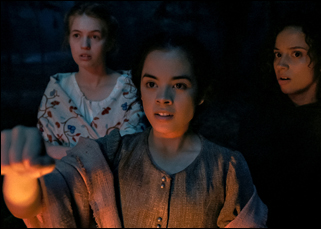
The idea of having to invent three different worlds, keep this shared narrative core driving everything forward and also having new cast come in for ’78, it was so much that while we were making it and while I was on the ground, that was not anything that was seeping in. It was like, “Okay, I live in ‘Fear Street’ now. This is the only thing I’m going to do for the rest of my life.” That what it felt like. It was 106 days, which were mostly nights and it was so intense that when we got into post, it’s weird to say, but a pleasant surprise [when I realized] “Oh we made three very, very different movies.” That in itself was this joy of the process — like the process worked. All of the time that I had my head down while we were shooting, we did three different movies, and then being able to find how the characters changed and moments [where we could flash back or forward] — there’s a few moments in [“1978”] in the framing [device] right before Deena is about to put Sarah Fier’s bones to rest that she has this moment where we show Simon and Kate and Sam [from “1994”] and that wasn’t scripted. It was there in Kiana’s eyes as Deena in thinking and feeling it, but we realized we had the footage to show it, so when those moments came up, it was really exciting.
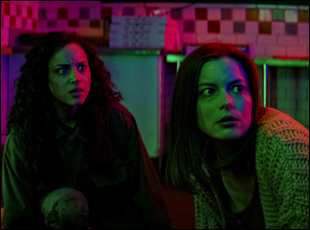
It’s been really, really amazing. It’s so surreal to be working on this by myself – with my crew – for the most part, in our little bubble and suddenly have it be in the world. And for Netflix to create such an amazing release structure and so supportive, it’s just been awesome. I try not to fall into the black holes of the internet, but every once in a while, I’ll sneak on Twitter or whatever and peek and it’s really been embraced by the queer community and that to me is just the coolest part of all of it because hopefully, you feel scared and hopefully you’re like, “this is gross” – all of the things that I want from a horror story, but the fact that we have young queer people that are like, “This is sweet. I’ve never seen myself represented like this,” to me, that’s the awesomeness.




